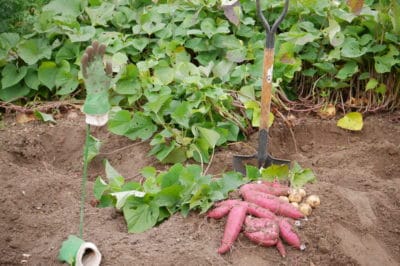Companion Planting Basics
Companion planting is a technique practiced by many gardeners. In some cases, it’s purely for ornamental purposes, as when you combine vegetables and flowers. In other cases, it’s with the idea of deterring insect pests or improving the soil. Companion planting can help make more efficient use of space. It also includes avoiding certain plants, known as antagonists, like winter squash.
Sweet Potato Requirements
Sweet potatoes have certain climate and cultural requirements; companion plants usually need the same. For example:
- Warm-season plants, sweet potatoes need a long growing season.
- Soil should be of moderate fertility and must drain well.
- Soil should be loose and friable; add humus as necessary.
- Sweet potatoes need at least one inch of water a week.
Growth Patterns
Companion planting should take growth patterns into account. The sweet potato is a sprawling vine, similar in growth habit to winter squash. A plant that grows vertically, like pole beans or tomatoes, will not tangle with the vines the way other vining plants will. Root crops like beets use the upper layers of soil while sweet potatoes grow deeper.
Insect Repellants
Herbs interplanted with sweet potatoes can help repel insects. Oregano and dill, both annuals, grow in the same season as the sweet potato. Dill attracts hoverfiles and predatory wasps to eat insect pests. Summer savory can deter the sweet potato weevil. Thyme is another good choice, but as a perennial, it’s better planted in pots set on top of the soil between the sweet potato plants.
Improving the Soil
Legumes and sweet potatoes make good companions. The legumes add nitrogen to the soil. Bush beans are not a good choice, as the rampant sweet potato vines can smother them. Pole beans, however, stay above the vines, which can’t climb the poles. Once the vines begin to yellow near harvest time, plant beets and carrots to loosen soil and grow through the fall and winter.
Maximizing Space and Yield
Sweet potatoes draw their nourishment from the area right around the plant. Especially early in the season, you can plant quick-maturing crops in the area where the vines will eventually spread. Lettuce can be ready in 45 days. Chard is another quick-maturing crop that likes warm weather. Irish potatoes planted in early spring can come out as the sweet potatoes begin to spread.
